Intel’s Sandy Bridge i7-2820QM: Upheaval in the Mobile Landscape
by Jarred Walton on January 3, 2011 12:00 AM EST- Posted in
- Laptops
- Intel
- Sandy Bridge
- Compal
Mobile Sandy Bridge Medium Gaming Performance
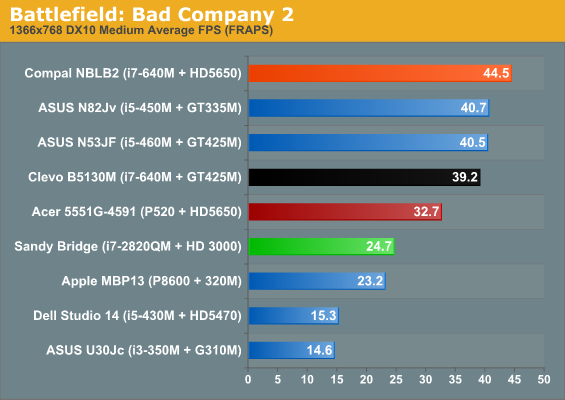
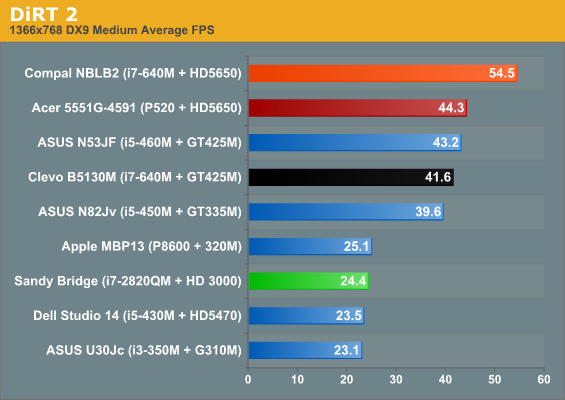
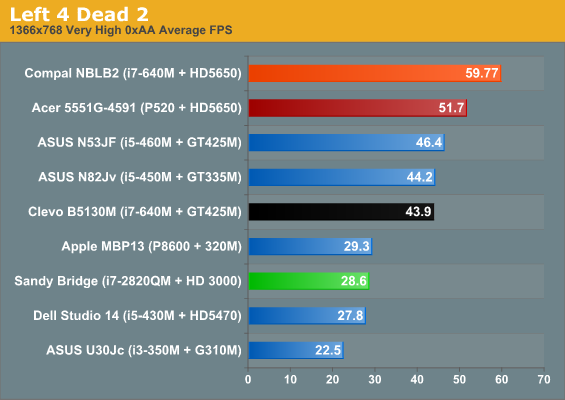

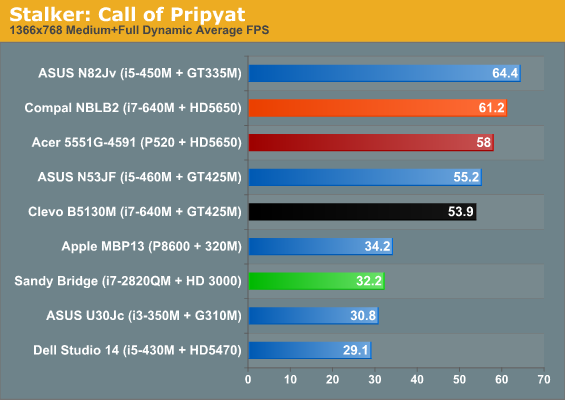
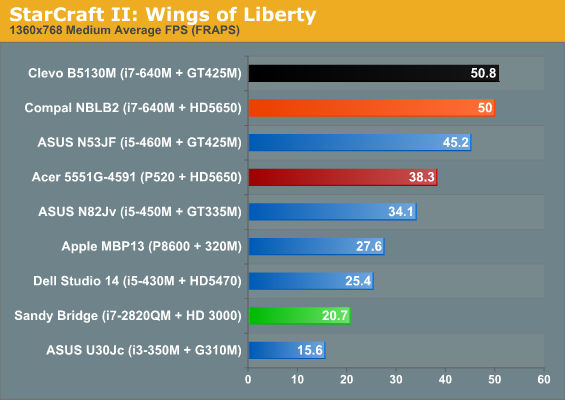
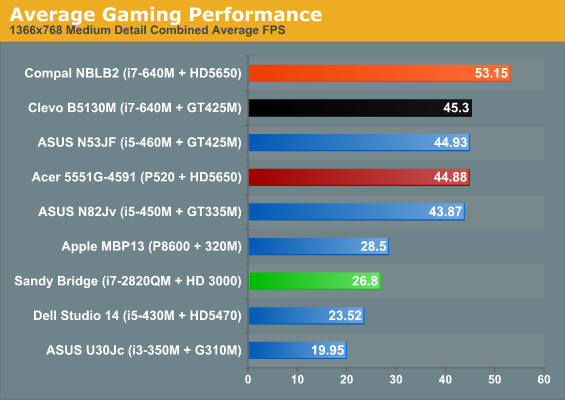
Moving up to medium detail, the picture becomes a lot less rosy. We’ll just forget about the Arrandale IGP and HD 4250 now, as they were generally slow to unplayable at Low settings and become untenable at Medium. Overall, HD 3000 still leads the HD 5470, but the GeForce 320M actually turns in better results at Medium detail and ends up 6% faster. The P520 + HD 5650 lead is now 67%, since more of the bottleneck is shifted to the GPU, or 98% when coupled to Arrandale. NVIDIA’s GT 425M also leads by 68%. If we’re looking for reasonably smooth gaming performance, only Mass Effect 2 and STALKER manage to squeak past the 30FPS mark.
At the Medium settings, we also encountered a few minor glitches with rendering games. For the above six titles, Left 4 Dead 2 is the only problem, with darker graphics than on other GPUs and a much more pronounced film grain effect. You can turn down the latter setting to compensate, but even at maximum brightness the game is still darker than on AMD and NVIDIA graphics. A driver update should be able to address this, but it does serve to illustrate the fact that not all titles will run 100% properly on the current Intel drivers.
That last point raises an interesting question: just how many games will have minor glitches or other issues with the Sandy Bridge IGP? Without testing each game for compatibility, we can’t provide an answer, but we did pull out a large selection of older and newer titles for additional testing. If you have any further requests, feel free to ask and we can try to see if the game(s) in question will run on Sandy Bridge or not—bearing in mind that we don’t have access to all current titles. So let’s see how SNB graphics fare on 14 additional games.










66 Comments
View All Comments
JarredWalton - Monday, January 3, 2011 - link
True, it's been around a while, but I found it interesting that while performance dropped, it wasn't the "slideshow effect". If the system sat idle, the CPU would start to cool down, so when I fired up a benchmark it would run fast for a little bit. It was very perplexing until I figured out what was happening. First run on MediaEspresso gave me 11s with Quick Sync. Then I ran it again and it was 17s. The next time it was suddenly down to 33s.QChronoD - Monday, January 3, 2011 - link
I'm hoping that someone will annouce something like ASUS's new U36JC that has an i5-2410 at CES. I'd love to be able to go a full day at school without needing to recharge in almost every class (and actaully be able to play minecraft between classes)PlasmaBomb - Monday, January 3, 2011 - link
That should read the GTX465 comes next...
PlasmaBomb - Monday, January 3, 2011 - link
To correct the correction (I was going by the graphs), the graphs for the G73J should read GTX460M (I noticed the reference to the GTX460M in the text later and checked the G73J article).God help us all when it comes to talking/writing about the Sandy Bridge chips themselves, "the i7-2539"...
JarredWalton - Monday, January 3, 2011 - link
Fixed, thanks. I had some good ones in those graphs... G73Jw with 260M and 456M, but no 460M! LOLiwodo - Monday, January 3, 2011 - link
now all that is left are Gfx drivers, i hope intel put 10x more resources at their current Gfx Drivers team.Other then that, i am waiting for Ivy Bridge........
ET - Monday, January 3, 2011 - link
I imagine that a single resolution is the best way to compare different machines, but it would have been nice to see some gaming benchmarks at the native res. 1600x900 is not a whole lot higher than 1366x768 (37% more pixels), so I imagine it's possible to game with low details at that resolution. Many Anandtech articles add such figures into the benchmark tables, and I was really missing them here.JarredWalton - Monday, January 3, 2011 - link
I ran out of time, but I did test 1600x900 at our "High" defaults. Umm... not really what you'd want, as everything is completely unplayable. Perhaps post-CES I'll get a chance to do additional testing, but my feeling is most actual notebooks using SNB will likely ship with a 768p display. Some might do 1080p as well, but they'll be more likely to include Optimus GPUs for gaming.therealnickdanger - Tuesday, January 4, 2011 - link
Good idea testing at 1366x768. Not only does it fall in line with most notebook screen resolutions, but it also give good indication of 720p performance. Given that many, many gamers play PS3 and 360 (most games being 720p@30fps), it's very good to see that most games are completely playable from low-medium settings. Some games could probably even get away with higher settings and still stay around 30fps.It's awesome that Intel is putting the "HD 3000" GPU in all its mobile chips, but I'm very curious how the different clock speeds of the GPU and CPUs will affect performance.
ULV Sandy Bridge numbers soon?
therealnickdanger - Tuesday, January 4, 2011 - link
Oh yeah, I forgot to add:What's with Dark Athena? Is it really that stressful to run or is there a driver issue?